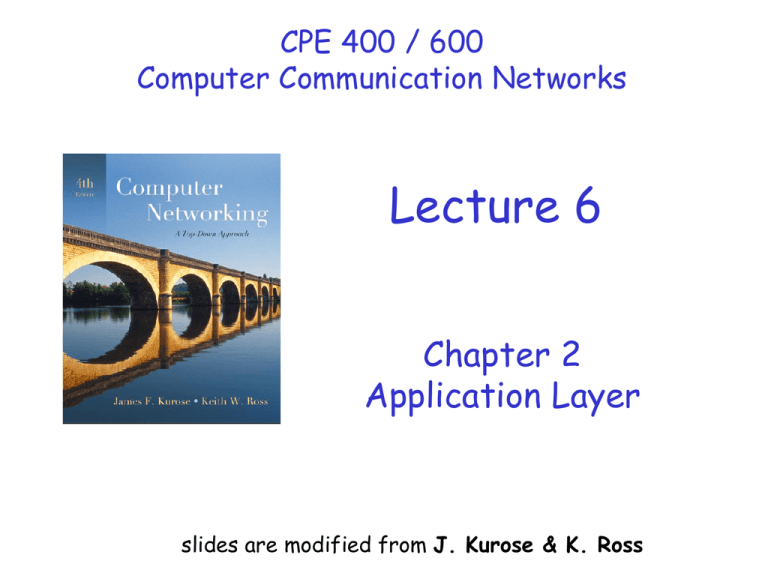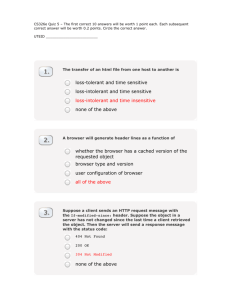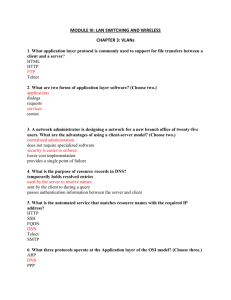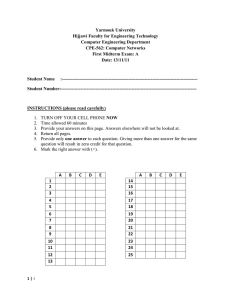Lecture #6: Application layer - Computer Science & Engineering
advertisement

CPE 400 / 600
Computer Communication Networks
Lecture 6
Chapter 2
Application Layer
slides are modified from J. Kurose & K. Ross
Chapter 2: Application layer
2.1 Principles of network applications
2.2 Web and HTTP
2.3 FTP
2.4 Electronic Mail
SMTP, POP3, IMAP
2.5 DNS
2.6 P2P applications
2.7 Socket programming with TCP
2.8 Socket programming with UDP
2: Application Layer
2
FTP: the file transfer protocol
transfer file to/from remote host
client/server model
FTP client contacts FTP server
TCP control connection
port 21
TCP data connection
port 20
FTP
FTP
at port 21
client
server
client authorized and browses
remote directory by sending commands over control connection.
when server receives file transfer command, server opens 2nd TCP
connection (for file) to client
after transferring one file, server closes data connection.
server opens another TCP data connection to transfer another file.
control connection: “out of band”
FTP server maintains “state”: current directory, earlier
authentication
2: Application Layer
3
FTP issues
Multiple connections are used
for each directory listing and file transmission
No integrity check at receiver
Messages are sent in clear text
including Passwords and file contents
can be sniffed by eavesdroppers
Solution
Secure FTP (SSH FTP)
• allows a range of operations on remote files
FTPS ( FTP over Secure Sockets Layer (SSL) )
Transport Layer Security (TLS) encryption
2: Application Layer
4
Electronic Mail
outgoing
message queue
user mailbox
Three major components:
user
agent
user agents
mail reader
composing, editing, reading
mail messages
mail
server
SMTP
mail servers
mailbox contains incoming
messages for user
message queue of outgoing
(to be sent) mail messages
simple mail transfer
protocol: SMTP
to send email messages
between mail servers
SMTP
mail
server
user
agent
SMTP
user
agent
mail
server
user
agent
user
agent
user
agent
2: Application Layer
5
Electronic Mail: SMTP [RFC 2821]
uses TCP to reliably transfer email message from client to
server (port 25)
command/response interaction
commands: ASCII text
response: status code and phrase
messages must be in 7-bit ASCII
uses persistent connections
Comparison with HTTP:
SMTP: push
HTTP: pull
both have ASCII command/response interaction, status codes
HTTP: each object encapsulated in its own response msg
SMTP: multiple objects sent in multipart msg
2: Application Layer
6
Scenario: Alice sends message to Bob
1) Alice uses UA to compose message and “to”
bob@someschool.edu
2) Alice’s UA sends message to her mail server; message placed
in message queue
3) Client side of SMTP opens TCP connection with Bob’s mail
server
4) SMTP client sends Alice’s message over the TCP connection
5) Bob’s mail server places the message in Bob’s mailbox
6) Bob invokes his user agent to read message
1
user
agent
2
mail
server
3
mail
server
4
5
6
user
agent
2: Application Layer
7
Mail message format
SMTP: protocol for exchanging email msgs
RFC 822: standard for text message format:
header lines, e.g.,
To:
From:
Subject:
different from SMTP commands!
body
header
blank
line
body
the “message”,
ASCII characters only
2: Application Layer
8
Message format: multimedia extensions
MIME: multimedia mail extension, RFC 2045, 2056
additional lines in msg header declare MIME content type
MIME version
method used
to encode data
multimedia data
type, subtype,
parameter declaration
encoded data
From: alice@crepes.fr
To: bob@hamburger.edu
Subject: Picture of yummy crepe.
MIME-Version: 1.0
Content-Transfer-Encoding: base64
Content-Type: image/jpeg
base64 encoded data .....
.........................
......base64 encoded data
2: Application Layer
9
Mail access protocols
user
agent
SMTP
SMTP
sender’s mail
server
access
protocol
user
agent
receiver’s mail
server
SMTP: delivery/storage to receiver’s server
Mail access protocol: retrieval from server
POP: Post Office Protocol [RFC 1939]
• authorization (agent <-->server) and download
IMAP: Internet Mail Access Protocol [RFC 1730]
• more features (more complex)
• manipulation of stored msgs on server
HTTP: gmail, Hotmail, Yahoo! Mail, etc.
2: Application Layer
10
POP3 and IMAP
More about POP3
Previous example uses “download and delete” mode.
Bob cannot re-read e-mail if he changes client
“Download-and-keep”: copies of messages on
different clients
POP3 is stateless across sessions
IMAP
Keep all messages in one place: the server
Allows user to organize messages in folders
IMAP keeps user state across sessions:
names of folders and mappings between message IDs and
folder name
2: Application Layer
11
Lecture 6: Outline
2.3 FTP
2.4 Electronic Mail
SMTP, POP3, IMAP
2.5 Domain Name System
Hierarchy
DNS protocol
2.6 Peer to Peer
File distribution
Information search
Skype
2: Application Layer
12
DNS: Domain Name System
People: many identifiers:
SSN, name, passport #
Internet hosts, routers:
IP address (32 bit) - used for addressing datagrams
“name”, e.g., ww.yahoo.com - used by humans
Domain Name System:
distributed database implemented in hierarchy of many name
servers
application-layer protocol host, routers, name servers to
communicate to resolve names (address/name translation)
note: core Internet function, implemented as applicationlayer protocol
complexity at network’s “edge”
2: Application Layer
13
DNS services
hostname to IP address translation
host aliasing
Canonical, alias names
mail server aliasing
load distribution
replicated Web servers: set of IP addresses for one
canonical name
Why not centralize DNS?
single point of failure
traffic volume
distant centralized database
maintenance
doesn’t scale!
2: Application Layer
14
Distributed, Hierarchical Database
Root DNS Servers
com DNS servers
yahoo.com
amazon.com
DNS servers DNS servers
org DNS servers
pbs.org
DNS servers
edu DNS servers
poly.edu
umass.edu
DNS serversDNS servers
Client wants IP for www.amazon.com; 1st approx:
client queries a root server to find com DNS server
client queries com DNS server to get amazon.com
DNS server
client queries amazon.com DNS server to get IP
address for www.amazon.com
2: Application Layer
15
DNS: Root name servers
contacted by local name server that can not resolve name
root name server:
contacts authoritative name server if name mapping not known
gets mapping
returns mapping to local name server
a Verisign, Dulles, VA
c Cogent, Herndon, VA (also LA)
d U Maryland College Park, MD
g US DoD Vienna, VA
h ARL Aberdeen, MD
j Verisign, ( 21 locations)
e NASA Mt View, CA
f Internet Software C. Palo Alto,
k RIPE London (also 16 other locations)
i Autonomica, Stockholm (plus
28 other locations)
m WIDE Tokyo (also Seoul,
Paris, SF)
CA (and 36 other locations)
13 root name
servers worldwide
b USC-ISI Marina del Rey, CA
l ICANN Los Angeles, CA
2: Application Layer
16
TLD and Authoritative Servers
Top-level domain (TLD) servers:
responsible for com, org, net, edu, etc, and all
top-level country domains uk, fr, ca, jp.
Network Solutions maintains servers for com TLD
Educause for edu TLD
Authoritative DNS servers:
organization’s DNS servers, providing
authoritative hostname to IP mappings for
organization’s servers (e.g., Web, mail).
can be maintained by organization or service
provider
2: Application Layer
17
Local Name Server
does not strictly belong to hierarchy
each ISP (residential ISP, company,
university) has one.
also called “default name server”
when host makes DNS query, query is sent
to its local DNS server
acts as proxy, forwards query into hierarchy
2: Application Layer
18
DNS name
resolution example
root DNS server
2
Host at cis.poly.edu
3
wants IP address for
gaia.cs.umass.edu
iterated query:
contacted server replies
with name of server to
contact
“I don’t know this name,
but ask this server”
TLD DNS server
4
5
local DNS server
dns.poly.edu
1
8
requesting host
7
6
authoritative DNS server
dns.cs.umass.edu
cis.poly.edu
gaia.cs.umass.edu
2: Application Layer
19
DNS name
resolution example
recursive query:
root DNS server
2
puts burden of name
3
7
resolution on contacted
name server
heavy load?
6
TLD DNS server
local DNS server
dns.poly.edu
1
5
4
8
requesting host
authoritative DNS server
dns.cs.umass.edu
cis.poly.edu
gaia.cs.umass.edu
2: Application Layer
20
DNS: caching and updating records
once (any) name server learns mapping, it caches
mapping
cache entries timeout (disappear) after some time
TLD servers typically cached in local name servers
• Thus root name servers not often visited
update/notify mechanisms under design by IETF
RFC 2136
http://www.ietf.org/html.charters/dnsind-charter.html
2: Application Layer
21
DNS records
DNS: distributed db storing resource records (RR)
RR format: (name,
Type=A
name is hostname
value is IP address
Type=NS
name is domain (e.g.
foo.com)
value is hostname of
authoritative name
server for this domain
value, type, ttl)
Type=CNAME
name is alias name for some
“canonical” (the real) name
www.ibm.com is really
servereast.backup2.ibm.com
value is canonical name
Type=MX
value is name of mailserver
associated with name
2: Application Layer
22
DNS protocol, messages
DNS protocol : query and reply messages, both with
same message format
msg header
identification: 16 bit #
for query, reply to query
uses same #
flags:
query or reply
recursion desired
recursion available
reply is authoritative
2: Application Layer
23
DNS protocol, messages
Name, type fields
for a query
RRs in response
to query
records for
authoritative servers
additional “helpful”
info that may be used
2: Application Layer
24
Inserting records into DNS
example: new startup “Network Utopia”
register name networkuptopia.com at DNS registrar
(e.g., Network Solutions)
provide names, IP addresses of authoritative name server
(primary and secondary)
registrar inserts two RRs into com TLD server:
(networkutopia.com, dns1.networkutopia.com, NS)
(dns1.networkutopia.com, 212.212.212.1, A)
create authoritative server Type A record for
www.networkuptopia.com; Type MX record for
networkutopia.com
2: Application Layer
25
Lecture 6: Outline
2.3 FTP
2.4 Electronic Mail
SMTP, POP3, IMAP
2.5 Domain Name System
Hierarchy
DNS protocol
2.6 Peer to Peer
File distribution
Information search
Skype
2: Application Layer
26
Pure P2P architecture
no always-on server
arbitrary end systems
directly communicate peer-peer
peers are intermittently
connected and change IP
addresses
Three topics:
File distribution
Searching for information
Case Study: Skype
2: Application Layer
27
File Distribution: Server-Client vs P2P
Question : How much time to distribute file
from one server to N peers?
us: server upload
bandwidth
Server
us
File, size F
dN
uN
u1
d1
u2
ui: peer i upload
bandwidth
d2
di: peer i download
bandwidth
Network (with
abundant bandwidth)
2: Application Layer
28
File distribution time: server-client
server sequentially
sends N copies:
NF/us time
client i takes F/di
time to download
Server
F
us
dN
u1 d1 u2
d2
Network (with
abundant bandwidth)
uN
Time to distribute F
to N clients using = dcs = max { NF/us, F/min(di) }
i
client/server approach
increases linearly in N
(for large N) 2: Application Layer
29
File distribution time: P2P
server must send one
Server
F
u1 d1 u2
d2
copy: F/us time
us
client i takes F/di time
Network (with
dN
to download
abundant bandwidth)
uN
NF bits must be
downloaded (aggregate)
fastest possible upload rate: us + Sui
dP2P = max { F/us, F/min(di) , NF/(us + Sui) }
i
2: Application Layer
30
Server-client vs. P2P: example
Client upload rate = u, F/u = 1 hour, us = 10u, dmin ≥ us
Minimum Distribution Time
3.5
P2P
Client-Server
3
2.5
2
1.5
1
0.5
0
0
5
10
15
20
25
30
35
N
2: Application Layer
31
File distribution: BitTorrent
P2P file distribution
tracker: tracks peers
participating in torrent
torrent: group of peers
exchanging chunks of a file
obtain list
of peers
trading
chunks
peer
2: Application Layer
32
BitTorrent (1)
file divided into 256KB chunks.
peer joining torrent:
has no chunks, but will accumulate them over time
registers with tracker to get list of peers, connects
to subset of peers (“neighbors”)
while downloading, peer uploads chunks to other peers.
peers may come and go
once peer has entire file, it may (selfishly) leave or
(altruistically) remain
2: Application Layer
33
BitTorrent (2)
Pulling Chunks
at any given time, different peers have different subsets of file
chunks
periodically, a peer (Alice) asks each neighbor for list of chunks
that they have.
Alice sends requests for her missing chunks
rarest first
Sending Chunks: tit-for-tat
Alice sends chunks to four neighbors currently sending her
chunks at the highest rate
re-evaluate top 4 every 10 secs
every 30 secs: randomly select another peer, starts sending
chunks
newly chosen peer may join top 4
“optimistically unchoke”
2: Application Layer
34
BitTorrent: Tit-for-tat
(1) Alice “optimistically unchokes” Bob
(2) Alice becomes one of Bob’s top-four providers; Bob reciprocates
(3) Bob becomes one of Alice’s top-four providers
With higher upload rate,
can find better trading
partners & get file faster!
2: Application Layer
35
P2P: searching for information
Index in P2P system: maps information to peer location
(location = IP address & port number)
File sharing (eg e-mule)
Index dynamically tracks the locations of files that peers
share.
Peers need to tell index what they have.
Peers search index to determine where files can be found
Instant messaging
Index maps user names to locations.
When user starts IM application, it needs to inform index
of its location
Peers search index to determine IP address of user.
2: Application Layer
36
P2P: centralized index
original “Napster” design
1) when peer connects, it
informs central server:
Bob
centralized
directory server
1
peers
IP address
content
2) Alice queries for “Hey Jude”
3) Alice requests file from Bob
1
3
1
2
1
single point of failure
performance bottleneck
copyright infringement:
Alice
“target” of lawsuit is obvious
2: Application Layer
37
Query flooding
fully distributed
no central server
used by Gnutella
Each peer indexes the files it makes available for
sharing (and no other files)
overlay network: graph
edge between peer X and Y if there’s a TCP connection
all active peers and edges form overlay net
edge: virtual (not physical) link
given peer typically connected with < 10 overlay
neighbors
2: Application Layer
38
Query flooding
Query message
sent over existing TCP
connections
peers forward
Query message
QueryHit
sent over
reverse
Query
path
File transfer:
HTTP
Query
QueryHit
QueryHit
Scalability:
limited scope
flooding
2: Application Layer
39
Gnutella: Peer joining
joining peer Alice must find another peer in
Gnutella network: use list of candidate peers
2. Alice sequentially attempts TCP connections with
candidate peers until connection setup with Bob
3. Flooding: Alice sends Ping message to Bob; Bob
forwards Ping message to his overlay neighbors
(who then forward to their neighbors….)
peers receiving Ping message respond to Alice
with Pong message
4. Alice receives many Pong messages, and can then
setup additional TCP connections
1.
2: Application Layer
40
Hierarchical Overlay
between centralized
index, query flooding
approaches
each peer is either a
super node or assigned to
a super node
TCP connection between
peer and its super node.
TCP connections between
some pairs of super nodes.
Super node tracks content
in its children
ordinary peer
group-leader peer
neighoring relationships
in overlay network
2: Application Layer
41
P2P Case study: Skype
Skype clients (SC)
inherently P2P: pairs
of users communicate.
proprietary
Skype
login server
application-layer
protocol (inferred via
reverse engineering)
hierarchical overlay
with SNs
Index maps usernames
to IP addresses;
distributed over SNs
Supernode
(SN)
2: Application Layer
42
Peers as relays
Problem when both Alice
and Bob are behind
“NATs”.
NAT prevents an outside
peer from initiating a call to
insider peer
Solution:
Using Alice’s and Bob’s SNs,
Relay is chosen
Each peer initiates session
with relay.
Peers can now communicate
through NATs via relay
2: Application Layer
43
Lecture 6: Summary
File Transfer Protocol
Electronic Mail
SMTP,
POP3, IMAP
Domain Name Service
Hierarchy
DNS protocol
Peer to Peer applications
File distribution
Information search
Skype
2: Application Layer
44








